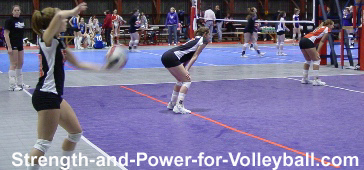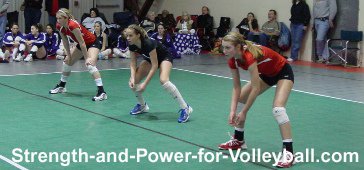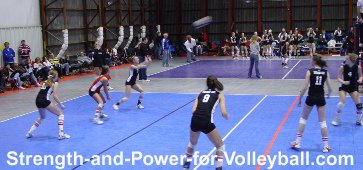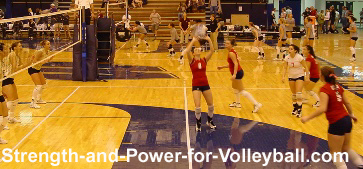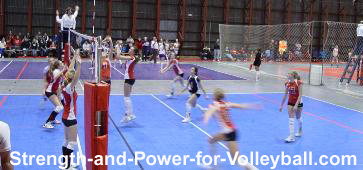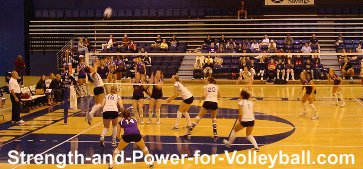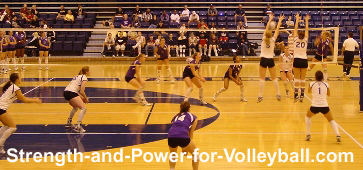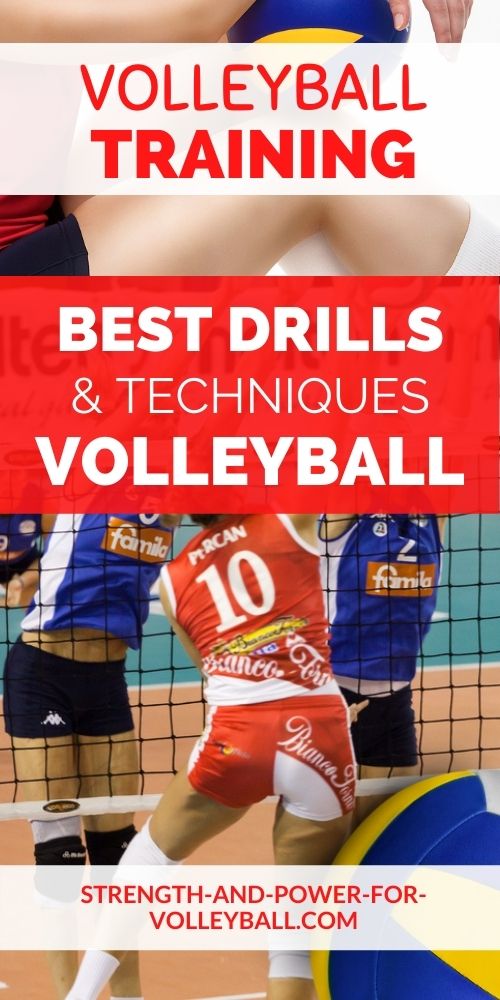Volleyball Techniques and Strategies
The volleyball techniques - serving, passing, setting, hitting, blocking, and digging - are the six major volleyball skills players must develop.
Serving
All volleyball players should know proper techniques for serving floaters and jump serves. Servers should spend time practicing a pre-serve routine. Developing a routine will help servers focus and be ready to serve.
The basic volleyball techniques for serving are...
- Toss the ball in front of your serving shoulder.
- Keep your elbow high and back.
- Contact the middle of the ball with the middle of your hand.
- Follow through on your armswing.
These are just guidelines. If you have better success serving a different way, that's fine, do what works best.
A clean solid contact is key to a good floater. I know when I'm struggling getting a solid contact on my float serve, I'll contact the ball with more of a bent elbow.
I feel this gives me a little more of a window for adjusting to the height of the toss to get that solid contact.
For example, if I were to try and contact the ball with an extend arm every time I serve, the height of my toss would be more critical to getting a good solid contact.
Passing
Common volleyball techniques for great passing include...
Keep your body's center of gravity level when moving. Basically, you want to be light on your feet when getting in position to pass.
Being able to take steps without bouncing off the ground is important because it's harder to focus on the ball when you're bouncing up and down.
Strong eccentric quadriceps strength leads to a better ability to absorb the force from the ground when taking steps.
Form a solid platform with your forearms. Extend your arms while locking your elbows and turning your hands down at the wrists. You want to form a solid platform that provides stability.
Use your hips and legs to pass, not the arms. Being able to move quickly into position is very important.
Concentrate on getting into a stable position quickly, every time you pass. If you utilize this technique every time you pass, with repetition you will train yourself to be a better passer.
If you don't have very good movement skills or are just lazy when moving to pass, you'll have to adjust your technique on the fly which will lead to fewer consistent passes.
Volleyball techniques for overhead passing with your hands
If you are going to take the ball with your hands to pass, it is usually easier to pass by using a quick finger action to direct the ball to your target.
This quick finger action (sometimes multiple contacts of the fingers) allows for better control. Only do this on the first team contact because on the second and third contact, multiple contacts are illegal.
This works real well for balls that are hard driven or are really far way from your target.
On balls that come right over the net or fall to you pretty slowly, it may be easiest to just take the ball like you normally would with your hands(your normal setting motion).
Setting
Volleyball techniques for setting consists of the following steps.
- Get to the target. The second ball is always the setters. Seeing as though they know this ahead of time, setters should be lined up properly and ready to move to the target.
- Be ready to move from the target. If possible, take your first step directly to where the ball is being passed.The better judgment the setter has, the better job they will do in moving straight to where the ball is going. If they leave too early or they make a bad judgment, they'll step in the wrong direction and not make it there as quickly.
- Beat the ball to the spot. Setters should try anticipating where the ball is going to be passed. By paying attention to how tough the serve is and watching the way their passer is handling the ball, they may get a good read on the pass.
- Stop and set. Everything done up until now dictates how well the setter is able to stop and set. Obviously, in many situations the setter will need to be moving while setting. But ideally, the setter should get there and transfer weight from the left to right foot when setting the ball.
Attacking at the Net
Develop consistent footwork. Volleyball techniques for the approach consist of 3 or 4 foot steps. The 3 step approach would be, left-right-left for right handed attackers, right-left-right for left handed attackers. volleyball techniques player approaching Before training players to develop a consistent 4 step approach or 3 step approach, it may be best to first work on just the last two steps.
Your last two steps are the ones that matter the most. First concentrate on learning the last two before working on 3 or 4 step approaches.
Volleyball techniques for executing an attack hit include...
1. Approaching quick. To jump high, youve got to move fast. Really focus on stepping quickly (especially the last couple) in order to maximize your jump height.
2. Swing your arms back. By swinging your arms back you will take advantage of elastic energy and your nervous systems stretch reflex which can add inches to your vertical.
3. Bring both your arms up. By bring both your arms up you will continue with the momentum of going up which will help maximizing your height. Also, you will be in a better body position to hit.
4. Contact the ball in front of your hitting shoulder. It's best to contact the ball at the same spot every time you hit. This develops a consistent armswing.
Volleyball techniques of a hitters footwork (jumping from the correct spot) have a big influence on you hitting the ball in your sweet spot.
5. Put top-spin on the ball. Being able to put top-spin on the ball when you hit allows you to have better angles when hitting, thus more court to hit into.
This is often called snapping the wrist when contacting the ball.
Blocking
Volleyball techniques for blocking involve learning to see the court and making quick decisions at the net when preparing to block.
Having good court vision involves making good judgments while watching the setter, the ball, and hitters.
Good court vision. You often can predict where the setter is going to set the ball by watching the ball after it's passed.
The better you are able to judge where the ball is being passed, the better you can predict what the setter is going to do with it.
Watching the setter and hitters is critical to getting in the best position to block.
Identify the front row players. All the blockers should know who the front row players are before the serve.
Also, identify the setter as front row or back row to know if the setter can legally attack the second ball.
The volleyball techniques shuffle and crossover step are used to move into optimal blocking position.
Shuffle step. The shuffle technique is probably easiest because the hips stay square to the net.
Crossover step. The crossover is harder because you turn your hips during the movement and you need to get squared back up to the net before you jump.
The crossover is better for when you have to travel far to get in position to block because you can get there faster than shuffling.
Jump straight up, and penetrate the net
Blockers need good balance and stability to develop a consistent block jump.
The better a blocker is at jumping up and not floating, the better they will be at staying out of the net and penetrating their block into the opponent's space.
Wide fingers and thumbs up when blocking. Keep the fingers spread wide and tight and thumbs pointing up to prevent jamming your fingers.
Spreading your fingers wide will also allow you to take up more space.
Volleyball techniques for your blocking hands.Angle your hands to block the ball into your opponents court. The outside blocker should reach and penetrate a little more with the outside hand.
This will give that outside hand a little better angle for blocking the ball into the court and not out of bounds. If you're confident you won't block the ball back out of bounds, it's always a good idea to surround the ball with your hands when blocking.
Digging
Start in a defensive position lined up around the block. Know what area your blockers are going to take up (line or angle).
The basics of volleyball techniques for digging...
- Be up on your toes and on the balls of your feet, not on your heels.
- Be ready to get in a stable position to dig a hard driven ball.
- Be ready to move to run down a shot or tip.
- Arms are bent and in front of you ready to react to dig a ball with your forearms or to play a ball overhead.
- Eyes are focused on the hitter watching for any hint as to what they are going to do.
Cushion hard driven balls. You should try to absorb the hit with your arms to keep the ball on your side of the net.
If you can keep the ball on your side, your team has a better chance of winning the rally with your setter setting an attacker.
Volleyball techniques for going to the floor. Players are encouraged to stay on their feet when making plays on the ball.
If you enjoyed these tips and would like to keep it close to you at any time, just save this pin to your Pinterest Volleyball Training Board.
For making emergency plays, there are five common techniques...
1. Collapse. From a low defensive position, a player might collapse to the ground in order to make a last second move to play the ball. The collapse is used most often when a ball falls shorter than anticipated.
2. Sprawl. Anticipating the ball falling out in front of them, a defender might use the sprawling technique to take a lunge forward and reach to make a play.
Sprawling volleyball techniques are just like the collapse except the defender has time to take a step and reach.
3. The dive. This is similar to the sprawl except the body is more in an airborne position when making a the play.
4. Pancake. Defensive players can perform a pancake to save a ball from hitting the floor. The pancake is similar to a sprawl except the fingers are spread firmly and placed on the ground to meet the ball.
Pancaking can be one of the good volleyball techniques of playing a ball because if you perform a good pancake, you often will get a good bounce that will allow your teammates to keep the ball in play.
5. Shoulder or barrel roll. Defenders can often use a rolling technique by extending to the right, left, or forward in attempting to get the ball up by playing the ball close to the floor.
After playing the ball the players use their momentum to roll over their body and regain their balance in a position ready to move.
Rolling is probably the safest of the emergency volleyball techniques because players don't really hit the ground hard.
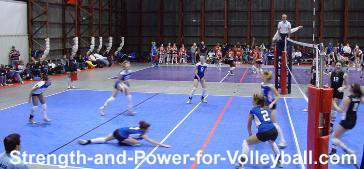
Volleyball Techniques Related Pages
Spike Technique and Drills
Volleyball hitting technique tips and tricks for learning quickly how to spike a volleyball. Step by step volleyball spiking drills to help you master hitting a volleyball.
Setter Training
Volleyball setter training for learning how to set to compete at a high level. To be the best you need to train like the best. Follow this guide to master volleyball setting skills.
Overhead Defense
Overhead dig for passing the ball with your hands during defense. For hard spikes to the head, you need to take the ball with your hands. Overhead hand setting.
Back Row Attacking
Back row hitting for spiking the volleyball from beyond the 3-meter line. D ball sets for spiking out of right back position. Broad jump technique, footwork, for power.
Setter Attack on 2
Setter dump techniques. Learn how to attack the second ball as a setter. When to dump and when to set. Be deceptive and fool the blocker and defender. How to dump.
How to Hit Left-Handed
Left handed spike in volleyball tips. How to approach and spike a volleyball for left handed volleyball players. Lefty footwork tips. Advantages for lefties.
Passing Footwork Tips
Passing in volleyball techniques for success in serve receive. Footwork and anticipating the server is the key to passing. If you move your feet early and read the ball.
Jump Float Technique
Jump float serve is the serve that tends to put the most pressure on the passers. The keys to a good float serve are mastering the toss, approach, and contact. Hit the ball in the midline to create...
Learn How to Spike the Ball Harder - Secrets to Rotational Power
Develop spiking power for hitting the ball harder and more explosive. Learn the correct technique for crushing the ball.
Skill Development and Important Tips
Skills development and important tips on learning volleyball. How is your blocking? What about skills for passing and digging? Do you need help with your hitting? The following are tips that will help improve your game.
Spike Approach, Teaching Timing is a Skill
Follow this unigue method for learning timing of the volleyball spike approach. Timing is a skill and can be taught by using this simple 4 step process...
Approaching to Spike
Volleyball approaches with techniques in hitting a volleyball. Volleyball spike approach secrets to jumping high and hitting hard. Hitting footwork..
Tips for Making Defensive Plays
Often times players get caught in awkward body positions when trying to make defensive plays on tipped balls, or deep hits...
Skills for Serving Floaters and Jumpers
Serving and passing are the two most important volleyball skills. Missed serves and easy serves are the two greatest...
Skills for Passing
Passing may be the most important of all volleyball skills. Players must develop the correct passing posture and movement techniques.
Skills for Setting
Developing good volleyball skills for setting is critical to putting your team in position to attack hit. Setters should develop skills to.
Skills for Improving Attack Hits
All attackers should develop good volleyball skills for hitting. When first learning to hit, you want to first learn the correct footwork for approach.
Skills for Blocking
Front row players need effective blocking volleyball skills. Good footwork for moving into position, jumping up and penetrating the net with...
Skills for Digging
Hard driven balls are often dug just by getting in good defensive position. By developing volleyball skills for digging hard drive...
Volleyball Jump Serve
Volleyball jump serve training is a great way to add a powerful offensive weapon to your arsenal. This skill can intimidate the opponent and help your team win.
Ready Position Explained
Volleyball ready position explained! Are you ready to take your volleyball game to the next level? Knowing the fundamentals of the game is essential.
How to Improve Skills
How to improve volleyball skills. Learn how to become a better volleyball player by focusing on developing skills. Everything is skill. You can learn how to do any skill in volleyball.
Tips for Setting a Volleyball
How to set a volleyball accurately and consistently without creating spin on the ball and avoiding being called for a double contact or lift.
What is Blocking?
What is blocking in volleyball. Read on to learn about the best techniques and strategies for blocking effectively in volleyball.
7 Serving Techniques and Strategies
How to serve in volleyball to get more aces! 5 styles of volleyball serves that will help your team score more points and win more games.
Volleyball › Volleyball Techniques
